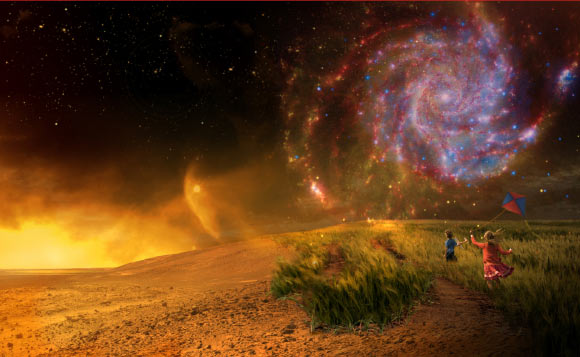Study: Life Might Be Common in Inflationary Universe | Astrobiology, Astronomy – Sci-News.com
In a paper published in the journal Scientific Reports, University of Tokyo’s Professor Tomonori Totani looked at how the building blocks of life could spontaneously form in the Universe — a process known as abiogenesis.

We might be the only intelligent life in the observable Universe. Image credit: NASA.
In spite of recent rapid development of biology, chemistry, Earth science and astronomy, the origin of life through abiogenesis is still a great mystery in science.
A prominent feature of life is the ordered information stored in DNA and RNA, and how such information appeared from abiotic processes is a crucial issue.
“As the only life we know of is based on Earth, studies on life’s origins are limited to the specific conditions we find here,” Professor Totani said.
“Therefore, most research in this area looks at the most basic components common to all known living things: RNA.”
“This is a far simpler and more essential molecule than the more famous DNA that defines how we are put together.”
“But RNA is still orders of magnitude more complex than the kinds of chemicals one tends to find floating around in space or stuck to the face of a lifeless planet.”
RNA is a polymer, meaning it is made of chemical chains, in this case known as nucleotides. Given sufficient time, nucleotides can spontaneously connect to form RNA given the right chemical conditions.
Researchers don’t know how an RNA polymer long enough to have a self-replicating activity (RNA polymerase ribozyme) emerged from prebiotic conditions and then triggered evolution.
RNA molecules shorter than 25 nucleotides do not show a specified function, but there is a reasonable hope to find a functioning replicase ribozyme longer than 40-60 nucleotides. RNA polymerase ribozymes produced in lab experiments so far have a length longer than 100 nucleotides.
“Current estimates suggest that magic number of 40 to 100 nucleotides should not have been possible in the volume of space we consider the observable Universe,” Professor Totani said.
“However, there is more to the Universe than the observable. In contemporary cosmology, it is agreed the Universe underwent a period of rapid inflation producing a vast region of expansion beyond the horizon of what we can directly observe. Factoring this greater volume into models of abiogenesis hugely increases the chances of life occurring.”
Indeed, the observable Universe contains about 1022 stars. Statistically speaking, the matter in such a volume should only be able to produce RNA of about 20 nucleotides.
But thanks to rapid inflation, the Universe may contain more than 10100 stars, and if this is the case then more complex, life-sustaining RNA structures are more than just probable, they’re practically inevitable.
“Like many in this field of research, I’m driven by curiosity and by big questions,” Professor Totani said.
“Combining my recent investigation into RNA chemistry with my long history of cosmology leads me to realize there is a plausible way the Universe must have gone from an abiotic state to a biotic one. It’s an exciting thought and I hope research can build on this to uncover the origins of life.”
_____
T. Totani. 2020. Emergence of life in an inflationary Universe. Sci Rep 10, 1671; doi: 10.1038/s41598-020-58060-0





